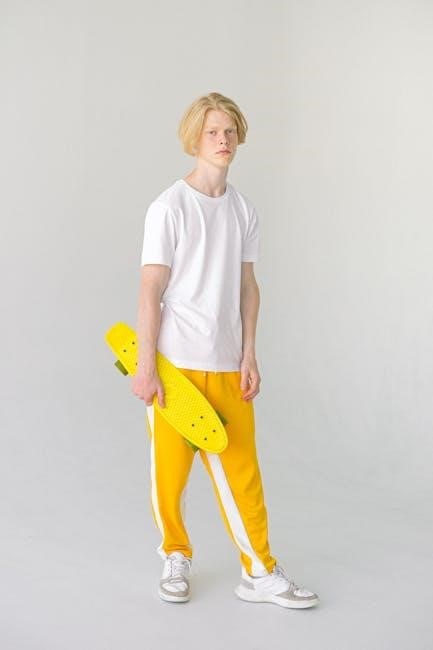Choosing the right skateboard length is crucial for optimal performance, comfort, and style, making it a key factor for every rider of all levels and preferences.
1.1 Importance of Skateboard Length
Skateboard length plays a pivotal role in determining performance, stability, and overall riding experience. A board that is too short or too long can hinder control and maneuverability, making it difficult to perform tricks or cruise comfortably. The right length ensures proper balance, allowing riders to execute movements with precision and confidence. It also impacts the board’s responsiveness, with shorter boards offering quicker turns and longer boards providing stability at higher speeds. Additionally, the length affects the deck’s real estate, influencing foot placement and comfort. Choosing the correct length is essential for maximizing fun and progress in skateboarding, regardless of skill level or riding style;
1.2 Purpose of the Guide
This guide aims to simplify the process of selecting the ideal skateboard length by addressing various factors such as rider height, weight, skill level, and personal preference. It provides insights into different skateboard types, including cruisers, shortboards, and longboards, helping riders understand which length suits their specific needs. The guide also delves into measuring techniques like deck length and wheelbase, offering a comprehensive size chart to aid decision-making. By highlighting the pros and cons of different lengths and common mistakes to avoid, this guide ensures that riders choose a skateboard that enhances their performance, comfort, and overall riding experience, whether they are beginners or seasoned skateboarders. Ultimately, it serves as a valuable resource for making informed choices in the world of skateboarding.
Understanding Skateboard Types
Skateboards come in various types, each designed for specific riding styles and preferences, differing in deck length, wheel size, and overall design to suit different needs and terrains.
2.1 Cruisers
Cruisers are a popular type of skateboard designed for relaxed, smooth rides on flat surfaces like sidewalks, bike paths, or streets. Typically measuring between 25-30 inches in length, cruisers are slightly longer than shortboards but shorter than longboards, offering a balanced feel. Their decks are often wider and softer, providing comfort and stability for cruising. Cruisers usually feature softer, larger wheels that absorb shocks and grip well on rough surfaces, making them ideal for casual, laid-back rides. They are great for beginners or riders who prioritize comfort and ease over high-speed performance or tricks. Cruisers are versatile and can be used for commuting, carving, or simply enjoying a leisurely ride.
2.2 Shortboards
Shortboards are the most common type of skateboard, typically measuring between 28 and 33 inches in length. Designed for versatility, they are ideal for street skating, tricks, and technical maneuvers. Their compact size and lightweight construction make them highly maneuverable, allowing riders to perform flips, grinds, and other tricks with ease. Shortboards are suitable for riders of all skill levels, from beginners learning the basics to advanced skaters perfecting their techniques. The deck width usually ranges from 7 to 10 inches, catering to different foot sizes and personal preferences. Overall, shortboards are a popular choice for those who prioritize agility, control, and the ability to perform a wide range of tricks and maneuvers.

2.3 Longboards
Longboards are significantly longer than shortboards, typically ranging from 33 to 60 inches in length, making them ideal for speed, stability, and long-distance skating. They are popular for commuting, downhill racing, and casual cruising due to their smooth ride and ability to cover ground efficiently. The extended deck length provides more room for foot placement, while the wider wheelbase enhances balance and control at higher speeds. Longboards often feature larger wheels, which contribute to their speed and shock absorption capabilities. They are a great choice for riders who prioritize comfort and efficiency over trick performance. However, their larger size and weight can make them less portable and more challenging to maneuver in tight spaces compared to shorter boards.
2.4 Old School Boards
Old School Boards are a type of skateboard that pays homage to the classic designs of the late ’70s and ’80s, offering a retro feel and unique style. These boards typically feature a wider and more rounded shape compared to modern shortboards, making them ideal for carving and cruising. They often have a longer length, generally ranging from 29 to 33 inches, and a wider deck, which provides stability and comfort for riders. Old School Boards are popular among skaters who enjoy a more relaxed, laid-back skating experience and are not focused on performing tricks. They usually come with larger, softer wheels, which enhance the smoothness of the ride and allow for better grip on various surfaces; These boards are perfect for those who appreciate a nostalgic vibe and are looking for a fun, casual way to enjoy skating.

Factors Influencing Skateboard Length
Skateboard length is influenced by rider height, weight, skill level, and personal preference, ensuring optimal performance, comfort, and style for various skating styles and preferences.
3.1 Rider Height and Weight
Rider height and weight are critical factors in determining the ideal skateboard length. Taller riders typically benefit from longer boards, as they provide better stability and control. Conversely, shorter riders may find shorter boards more manageable and easier to maneuver. Weight also plays a role, as heavier riders may prefer longer or sturdier boards for added durability and balance. While there are general guidelines, personal preference often influences the final choice. Balancing these factors ensures a skateboard that feels comfortable and performs well for the rider. Proper alignment of height, weight, and board length enhances the overall skating experience, making it essential to consider these elements carefully.
3.2 Skill Level and Riding Style
Skill level and riding style significantly influence the choice of skateboard length. Beginners often benefit from longer boards, as they provide greater stability and balance. Intermediate riders may prefer shorter boards for easier maneuverability and trick performance; Advanced riders can adapt to various lengths depending on their specific style, such as street, vert, or cruising. Riding style also plays a role; cruisers and commuters often opt for longer boards for speed and comfort, while trick-oriented riders favor shorter, more responsive decks. Balancing skill level with personal riding style ensures the best fit, enabling riders to perform at their best and enjoy a more satisfying experience on the board.
3.4 Personal Preference
Personal preference plays a significant role in choosing skateboard length, as it directly impacts the riding experience. Some riders prefer longer boards for their stability and smooth ride, making them ideal for cruising or commuting. Others opt for shorter boards, which are more agile and easier to maneuver for tricks and tight spaces. Aesthetics and brand loyalty can also influence decisions, as some riders prioritize the look and feel of their board. While practical factors like skill level and riding style are crucial, personal preference ensures the board feels right to the rider, enhancing enjoyment and performance. Balancing personal taste with practical needs is key to finding the perfect fit.

Measuring Skateboard Length
Measuring skateboard length involves assessing the deck length and wheelbase, both critical for determining the right size. Accurate measurements ensure optimal performance and rider comfort.
4.1 Deck Length
Deck length is the measurement from the tip of the nose to the end of the tail. It plays a significant role in determining stability, maneuverability, and overall performance. Longer decks provide more stability and are ideal for cruising, while shorter decks are better for tricks and tight turns. Deck length also influences the placement of the trucks and how the skateboard responds to movements. Riders should consider their height, shoe size, and skating style when choosing the appropriate deck length. While there are general guidelines, personal preference often dictates the final choice, making it essential to test different lengths before deciding.
4.2 Wheelbase
Wheelbase is the distance between the centers of the two trucks and significantly impacts a skateboard’s stability and maneuverability. It is measured from the inner bolts of one truck to the inner bolts of the other. A shorter wheelbase allows for tighter turns and quicker response, making it ideal for technical tricks and street skating. Conversely, a longer wheelbase provides greater stability at higher speeds, suiting cruisers and longboards. The wheelbase also affects the board’s turning radius and how it distributes weight. Riders should consider their skating style and preferences when selecting a wheelbase, as it directly influences the overall riding experience and performance.

Skateboard Size Chart
| Rider Height | Deck Length | Shoe Size |
|---|---|---|
| Under 5’4″ | 7.5″-7.75″ | 6-8 |
| 5’4″-5’8″ | 7.75″-8.0″ | 8-10 |
| 5’8″-6’0″ | 8.0″-8.25″ | 10-12 |
| Over 6’0″ | 8.25″+ | 12+ |
This chart provides a general guide for selecting skateboard size based on rider height and shoe size. Adjustments may be needed based on personal skating style and preference.
Pros and Cons of Different Lengths
- Shorter Boards (Under 8.0″): Highly maneuverable and portable, ideal for tricks and tight spaces; However, they may lack stability at higher speeds.
- Medium Boards (8.0″-8.5″): Balanced for both tricks and cruising, offering stability without sacrificing agility. Suitable for most skating styles.
- Longer Boards (Over 8.5″): Provide excellent stability and comfort for cruising and long-distance skating. However, they can be heavier and less maneuverable.

Understanding these trade-offs helps riders choose a board that aligns with their skating goals and preferences, ensuring a more enjoyable and effective skating experience.
Common Mistakes to Avoid
- Choosing a skateboard based solely on aesthetics rather than functionality or personal needs.
- Ignoring rider height and weight, leading to a board that is too small or too large.
- Assuming all skateboards are the same and not considering riding style or skill level.
- Overlooking the wheelbase and focusing only on deck length for stability.
- Not testing a board before purchase, resulting in poor fit or performance.
Avoiding these mistakes ensures a better skating experience, as the right board size enhances control, comfort, and overall enjoyment for riders of all levels.
Selecting the right skateboard length is a critical decision that impacts performance, comfort, and overall skating enjoyment. By considering factors such as rider height, weight, skill level, and personal preference, skaters can make informed choices. This guide has provided insights into various skateboard types, measurement techniques, and size charts to help navigate the selection process. Remember, the ideal board length balances stability, maneuverability, and style, ensuring a more enjoyable and safe skating experience. Avoid common mistakes like prioritizing aesthetics over functionality or neglecting to test a board. With the right knowledge, every skater can find their perfect match and elevate their skating journey.

